Mainer Merritt Fernald, who was the Harvard wunderkind of botany from around 1900 to 1950, said all of the 17 native Rumex species in North America were edible. He completely failed to mention most of them are so bitter it would take days of boiling to make them palatable, if ever.
Gastronomically there is a great divide in the Rumex family. Most are bitter, a few are tart. Those used for their bitter leaves alone include: Rumex arifolius, Rumex conglomeratus, Rumex crispus, Rumex hymenosepalus, Rumex mexicanus, Rumex occidentalis, Rumex salicifolius, Rumex venosus, Rumex violascens and Rumex patientia (the latter is cultivated in Europe and used like spinach.) Used for their leaves and seeds are: Rumex rispus, Rumex obtusifolius (also called Butter Dock because it was used to wrap butter) Rumex patientia, Rumex pulcher, and Rumex sanguineus. Eaten for their tart flavor are: Rumex acetosa, Rumex acetosella, Rumex aquaticus var. fenestratus, Rumex articus, Rumex paucifolius, Rumex rugosus, Rumex sagittatus, Rumex vesicarius, and Rumex scutatus. The latter is too acidic to eat but is used for flavoring. It has one cultivar called the Silver Shield. Rumex maritimus seeds can be made into mush, no ethnobotanical mention of the leaves. A couple of species split the difference, Rumex alpinus, whose stalks are used like rhubarb, and the previously mentioned Rumex hymenosepalus, also called Canaigre.
Canaigre is a large plant. Its stems and petioles were eaten by Native Americans like rhubarb (after much boiling.) They were made into pies and compotes. The boiled leaves are rated as an excellent green once rid of their bitterness. The roots are not edible but are 35% tannin, a good source of that material. The root was also used for mustardy to brown dye. Several attempts have been made to make Canaigre a commercial crop but never succeeded.
The bitter Rumexes, or docks, have many medicinal application, from increasing red blood cell count to external use on wounds. Rumex juice is supposed to be good for stinging nettles bites but has not worked on me. The application I am most familiar with is using the long leaves of the Swamp Dock, Rumex verticillatus, as astringent bandages. Here in wet Florida the Swamp Dock — the only native — is the species spied most often except in winter or early spring. That’s when two versions of Sheep Sorrels sprout up , the previous Rumex acetosella, also known as Garden Sorrel, (upper leaves embrace the four-sided stem) and the larger Rumex hastatulus, called Wild Sorrel (the latter lacks rhizomes, produces marge masses of red flowers, and only reproduces by seed.) They are both tart and wonderful trail side nibbles. They can also be used in salads and or made into tart… tartlets. There are at least six cultivars of the Rumex acetosa: Belleville, Blonde de Lyon, Larghe Foglie Bionde, Low Oxalic Acid, Nobel and Profusion.
Many of the docks leaves have curly edges, the Curly Dock (Rumex crispus) being a notable example as well as the Canaigre. Such plants often grow in dry areas and are called self-irrigating. The leaf’s curls capture rain, mist and dew channeling the water towards the central leaf vein then down towards the root.
The seeds of several docks can be harvested, cooked and eaten but they are not high on the foraging list, nor are the roots which are never eaten. However Euell Gibbons, the original Eat-A-Pine-Tree guy, had a use for the roots. In Stalking the Wild Asparagus after discussing forcing greens in the winter from dandelion roots he writes:
“… take the front out of the box you are using, and lay the roots in tiers with the crowns facing the open side, sprinkling soil between the layers of roots. This will form a stack with a backward sloping top and a rounded face which will bear the colorful leaves. Cover the roots well with soil, and leave outside until after a hard freeze. A few weeks after being brought into the warmth, these roots will begin to produce pale, translucent, curled leaves of all colors. Snip and wash these vegetables rainbows carefully to prevent bruising. Tastefully arranged on top of a salad they make a dish that looks almost too pretty to eat.”
Worldwide there are 190 to 200 Rumex, all in the Buckwheat family. Several are food for butterflies. There are rumblings among botanists to move the tart Rumex into their own and different genus. Don’t hold your breath. Rumex comes from rumo, which is Dead Latin to suck, referring to the practice among Romans of sucking on the leaves to ease thirst. Modern Greeks call Rumex Lapatho. And now a new twist and an old recipe.
Fermenting Dock, by Pascal
I think I’m making some interesting new culinary discoveries with our humble Curly Dock. I bought this “Aveluk” from our local Middle Eastern store and it is a traditional Armenian dish. They basically sell dehydrated dock leaves which they
use to make soup. BUT…a simple dehydration does not really work, my own “avaluk” was still green after dehydration and did not taste the same. I think I know what the difference is. By making large strands and leave them hanging for a while, there is a fermentation going on before full dehydration giving it a special flavor. So with my next strands, I’ll just leave them hanging in the kitchen until dry. I did a quick test and I got the smell of cabbage after 3 days. Interesting… it’s all about details…
From Food Planet
Ingredients:
1 "tail" of aveluk,
1 garlic clove,
1 bunch of each: parsley, coriander, basil,
2 teaspoon white vinegar,
1 tablespoon of minced walnuts,
1 onion,
2 tablespoons of vegetable oil,
salt, pepper.
Soak aveluk for 1 day in cold water, then boil it in salted water for 10 minutes, take out of water, let water flow down.
Fry onion with vegetable oil, then add aveluk, fry for 5 more minutes. Cool this mixture, lay out on the plate, add vinegar, green, garlic, salt, pepper, thoroughly mix, garnish with walnuts.
Also by Pascal, curly dock nori

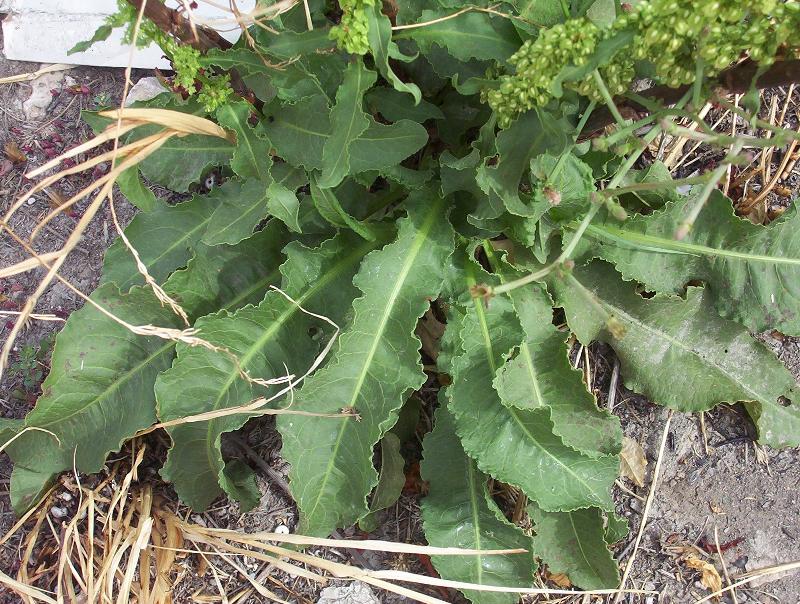

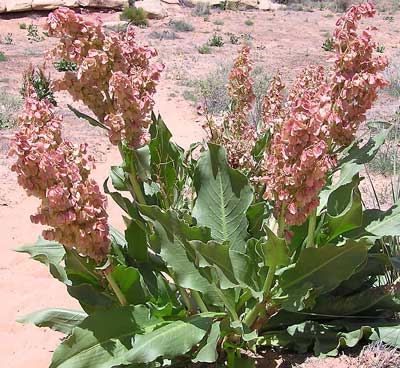
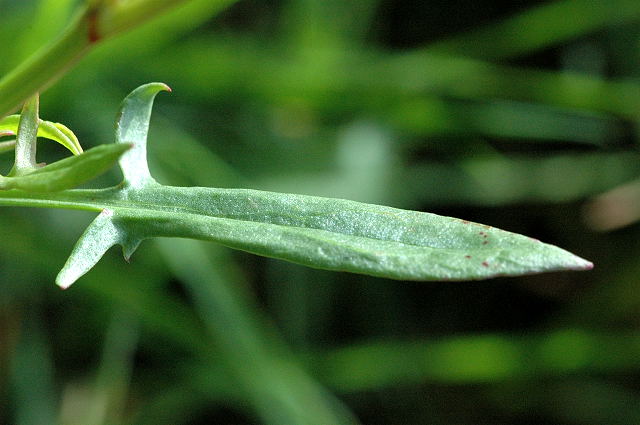

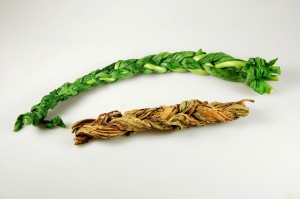
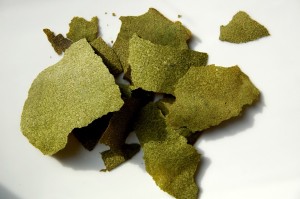

Greetings Green Deane,
I live in central Wisconsin and collect the Curly Dock seeds to use for flour, they work great and give my breads a nice maroon coloring. Well worth the effort of gathering and grinding into flour in my book.
Thanks for sharing your knowledge with us, very nice site.
Sa’Nap Nikki
Thanks for the information Sa’Nap Nikki, Please enlighten me on how to make curly Dock (which in particular) into flour.
Thanks.
Collect the seeds and grind away.
So I have seen two other posts now that caution against using Curly dock flour due to it’s laxative properties. Do you use only Rumex flour, use in combination then how much? What is your process for removing the chaff and husk?
I have used the ground rumex seed mixed with regular wheat, or gluten free flours, 50/50.
No tummy trouble whatsoever. It’s delicious.
Rumex species are distantly related to buckwheat, and are actually a superior plant in terms of suitability to modern agriculture for “grain” production. Clutivated buckwheat is a farily spindly plant that can lodge, doesn’t ripen its seeds all at once, tends to be very difficult to combine, and produces fairly unreliable and small yields of “grain”. Rumex on the other hand has a strong central stalk, flowers and ripens its seed all at once, certain species grow wild in the Mohave desert, it is perennial, has comparable lysine content to buckwheat (i.e. very high), and has the potential to produce upwards of 50bu/ac with a little improvement. Oh and rumex (the noxious weed) is native to the US, buckwheat (the wonder crop) is from china. So there’s alot more to this plant than just bitter leaves.
Rumex crispus.L, (Evelik), Curly dock, is very useful medicinal plant in Kars region of Turkey and cures catching-winter cold. Ardahan and Kars have very harsh winter and temperature drups -35C in winter. We do cook dishes with Curly dock; using onion, rice or whole weat, graunded beef, salt, black pepper, chily pepper and olive oil. .. Besides Curly dock we do use Rumex alpinus (Dağ pazısı), Monk’s rubarb, in our traditional cuisine. We add Sheep Sorrel leaves to our soups and salads and eat raw.
I’m an amateur soap maker, and I’ve come across references for colouring soap (and cloth) with both the root and leaves of dock leaves.
I grated some dock root over the weekend and will let it sit in olive oil for a month, before trying it out on a batch – apparently it will turn the soap a lovely pinky-blue.
I will definitely be trying out the seeds now too – thanks for all the great info.
Thanks for all of these ideas on what to do with rumex. I have a fondness for the plant when it goes to seed, as its brown combines well in my garden with purples and blues, so I keep some going. Now I’ll have to try some of these culinary ideas. I read the dried herb is used on epithelioma of the face, which I had never heard of til I looked up “rumex” online. I guess epithelioma covers a wide variety of skin conditions, many related to cancer. Anyone heard or know anything about that?
Somehow here in Iceland, I wonder if docks could be one of the future alternatives to grain. They grow so rampant and produce so much grain-like seeds, just like their cousin, the buckwheat.
Has anyone used the seeds? Do you add them raw or do you cook them?
I only have rumex longifolius here, northern dock.
As with buckwheat the papery husks should be removed and and the seed could be ground for a very whole ‘grain’ flour. The flour and the seeds though are somewhat bitter to the taste this is due partly to saponins in the seed coat and also to the high protein and partly to its unique amino-acid composition (i.e. the high lysine content). You may wish to leach the flour to try to reduce the levels of saponins. Rhubarb is somewhat closely related and can be used similarly though there is some question as to whether allowing rhubarb to go to seed will exhaust the roots or not. Both Rumex and Rheum Rhubarbum are very heavy feeders though so you’ll want to manure them well every year.
rather than “manure” every year, i would say “replace what you take out”. Manure is just one way to grow plants, and I wouldn’t even count chemicals.
I have curly dock here in East Texas and I love the lemony flavor. Sheep sorrel grows rampant and can overtake a cultivated area.
Rumex crispus seeds are a laxative. If you are going to grind them and use them as flour, don’t put in too much. I made curly dock seed crackers from a recipe I found on the Internet and ate 10 of them. Within a few hours I was excreting from every orifice in my body including some I never knew I had. So be careful and be sparing in use if you’re putting it in your baking as a flour. Let it be one kind of flour among several.
Not to belittle your bad experience, but your post gave me a big giggle! Orifices you never knew you had! LOL, thanks for the humor, and effect duly noted!
Here in my country (Portugal) in the region where I live Rumex pulcher and Rumex crispus are used in traditional soups. I can give the recipe so you can try! It’s a very simple soup but I love it! I’m showing you my version. I use kidney beans instead of fava beans because I prefer and there are traditional recipes with this kind of bean too. This soup is often used as a complete meal, if you put bread in the plate before serving.
Ingredients:
– 1 bunch dock leaves (I use Rumex pulcher and sometimes Rumex crispus)
– 350g (12oz) kidney beans (or fava beans)
– 1 onion, minced
– 2 garlic cloves
– 1 buch pennyroyal (Mentha pulegium) (you can use cilantro if you can’t find pennyroyal)
– 50ml (1.7 fl oz) extra virgin olive oil
– 1 goat or sheep milk fresh cheese (or any fresh cheese) (you can make the soup without the cheese), broken into pieces
– salt
– bread slices
1. Prepare the dock. Use only the leaves. If the leaves are big cut them in half. IMPORTANT: blanch the leaves (put them in boiling water for some seconds) so they loose the bitterness, and discard the water. Reserve the leaves. With a mortar and pestle grind the pennyroyal, salt and garlic cloves.
2. In a pan put the olive oil and heat it, then sauté the onion until soft. Add the grinded pennyroyal, salt and garlic to the pan, and then the beans. Stir it for 1 or 2 minutes
3. Add water until you have the amount you want. Taste and add salt if needed. When the beans are cooked (you take a shortcut if you use canned beans 😉 ) add the dock leaves and cook on low heat for 5 to 10 minutes (don’t let it overcook!). Finaly add the cheese and turn of the heat.
4. If you want the soup to be a complete meal add some small bread slices to a soup plate and then add the soup on top. I usually eat this soup this way.
Hope you like it! Let me know if you try this recipe and if you liked it.
I found your recipe after I figured out that I *had* 2 dock plants in my yard. Loved it (& my kid did, too, which was a surprise, since she knew I was cooking with weeds…lol)! Subbed coriander and feta cheese, & the feta balanced the flavors for me.
Thank you so much for posting; I look forward to making this one again!
Thanks so much for ideas on how to eat my dock! I’m trying the aveluk braid-making technique in the hopes that traditionally fermenting the leaves helps with the oxalic acid concentrations. There’s a neat link here http://www.eatthatweed.com/oxalic-acid/ all about oxalic acid in foraged plants; what it does and how to lower concentrations.
It’s late Winter on the Front Range (Boulder CO) and hardly anything is growing yet except Curly Dock (or possibly Canaigre Dock, I’m not 100 percent sure) which grows abundantly here and for some reason is already putting out full rosettes of tender leaves. I’d never tried dock, turned off by its reputation, but thought I’d give it a whirl. Very pleasant surprise. Young leaves, maybe no more than three inches, have a good flavor, delicate texture, and no trace of sourness cooked maybe a total of 5 minutes in two changes of water. For me, these were the first fresh greens of the season so it was doubly nice. The leaves are so young that most have not developed the ‘crispy’ edges, so the ID depends in part on last year’s dead seed stalks.
Does anybody know something about possible use (food, medicin) of Rumex confertus, a rather new species in Finland. It has big fresh leaves. It is very expansive and could produce very much, both leaves and seeds. The leaves are bitter though. Anyhow, it is worth to have it already for its own sake, a beautiful background in the wild garden.
Just sneering if the seeds collected for floor are the mature dried seeds when they are brown/ maroon or the green seeds? Thanks in advance for any reply. I’ve always been an amateur survivalist and have been studying in depth edible weeds for the last few years and trying to teach my wife and children, nieces and nephews and other relatives about what to look for, what to avoid and how to use.
My dock seeds are incredibly bitter. Collect them. Bake around 350 until dark. Rub to remove material around the seeds. Blow off the chaff. Grind into flour. Lots of work, but so plentiful it’s worthwhile. Tastes pretty good.
I have a 10 year of female Borzoi (Russian Wolf Hound) who seeks out and eats Dock quite aggressively. She will not eat the leaves if I pick them and put them in her bowl but she eats the fresh leaves in our “lawn”* when I take her for walks. She remembers where all the dock plants are and goes from plant to plant. If she eats too many of them she will regurgitate but if she only eats 4 or 5 leaves she is fine. She chops off the outer parts of the leaf, she does not pull the whole leaf off a plant. She comes up to me in the house and noses at me and pesters me to take her for a walk when she wants to eat “her plant”.
I am not sure what species the dock is but it looks a bit like the curly dock but the leaves are not quite so ruffled.
I have wondered if there is some active pharmacological component to the dock leaves. I can send a movie of her eating the dock.
*”Lawn” is a pretty loose term for the front yard, especially at this time of year. I have not mowed it yet and I found ground ivy, purple dead nettle and what I think are young Lactuca canadensis – the giant native blue wild lettuce out there today. Last year I had some of the giant blue lettuce that were 12 to 15 feet high. Here is a picture: http://www.batw.net/images/WeedNext2Bonnie1260x1888.jpg
I’ve had a lot of success using browned dock seed in beer recipes that call for rye, e.g. roggenbier or sahti. You need about 2 lbs for 5 gallons. The big advantage is that you don’t have to dehusk – mash like you would any other grain and it will still extract a very convincing rye flavor.
I love Patience Dock raw. It’s slightly crispy with a hint of lemon. If cooked, it is too mucilaginous for my taste, though it might make a great sauce. I really like the bitter and curley docks cooked. Raw, they are too bitter, but cooked they are delicious. Haven’t done anything with the seeds, but hopefully will do it this year.
I’ve eaten a lot of obtusifolius (which I call broadleaf dock) cooked with instant ramen and in beans. The younger, still green leaves are an excellent potherb. Just sour enough to add flavor, but not harsh or bitter. Then again, location matters! I was eating it from the side of an old logging road where it thrived, and wasn’t stressed like a city weed would be.